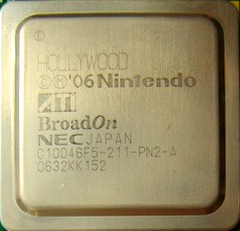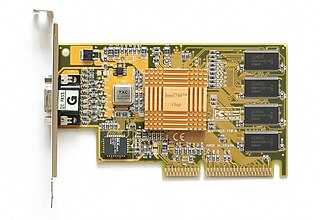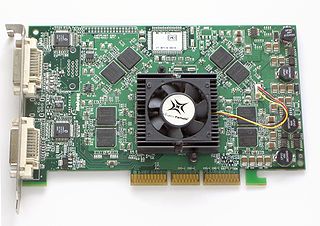 W
WA graphics processing unit (GPU) is a specialized, electronic circuit designed to rapidly manipulate and alter memory to accelerate the creation of images in a frame buffer intended for output to a display device. GPUs are used in embedded systems, mobile phones, personal computers, workstations, and game consoles. Modern GPUs are very efficient at manipulating computer graphics and image processing. Their highly parallel structure makes them more efficient than general-purpose central processing units (CPUs) for algorithms that process large blocks of data in parallel. In a personal computer, a GPU can be present on a video card or embedded on the motherboard. In certain CPUs, they are embedded on the CPU die.
 W
WThe ATI Rage is a series of graphics chipsets offering graphical user interface (GUI) 2D acceleration, video acceleration, and 3D acceleration. It is the successor to the ATI Mach series of 2D accelerators.
 W
WThe GeForce 10 series is a series of graphics processing units developed by Nvidia, initially based on the Pascal microarchitecture announced in March 2014.
 W
WThe GeForce 16 series is a series of graphics processing units developed by Nvidia, based on the Turing microarchitecture, announced in February 2019. The 16 series, commercialized within the same timeframe as the 20 series, aims to cover the entry level to midrange market, not addressed by the latter.
 W
WThe GeForce 20 series is a family of graphics processing units developed by Nvidia. Serving as the successor to the GeForce 10 series, the line started shipping on September 20, 2018, and after several editions, on July 2, 2019, the GeForce RTX Super line of cards was announced.
 W
WThe GeForce 30 series is a family of graphics processing units developed by Nvidia, succeeding the GeForce 20 series. The series was announced on September 1, 2020, and started shipping on September 17, 2020. The cards are based on the Ampere architecture and feature hardware-accelerated raytracing (RTX) with Nvidia's second-generation RT cores and third-generation Tensor Cores.
 W
WHollywood is the name of the graphics processing unit (GPU) used in Nintendo's Wii video game console. It was designed by ATI, and is manufactured using the same 90 nm CMOS process as Broadway, the Wii's central processing unit. Very few official details about Hollywood were released to the public by Nintendo, ATI, or any other company involved in the Wii's development. The Hollywood GPU is reportedly based on the GameCube's Flipper GPU and is clocked 50% higher at 243 MHz, though these clock rates have never been officially confirmed.
 W
WAMD Hybrid Graphics technology, is a collective brand from AMD for its Radeon line of discrete and integrated GPU, promoting higher performance and productivity while saving energy consumption in GPUs.
 W
WThe Intel i810 chipset was released by Intel in early 1999 with the code-name "Whitney" as a platform for the P6-based Socket 370 CPU series, including the Pentium III and Celeron processors. Some motherboard designs include Slot 1 for older Intel CPUs or a combination of both Socket 370 and Slot 1. It targeted the low-cost segment of the market, offering a robust platform for uniprocessor budget systems with integrated graphics. The 810 was Intel's first chipset design to incorporate a hub architecture which was claimed to have better I/O throughput and an integrated GPU, derived from the Intel740.
 W
WThe Intel Graphics Media Accelerator, or GMA, is a series of integrated graphics processors introduced in 2004 by Intel, replacing the earlier Intel Extreme Graphics series and being succeeded by the Intel HD and Iris Graphics series.
 W
WIntel Graphics Technology (GT) is the collective name for a series of integrated graphics processors (IGPs) produced by Intel that are manufactured on the same package or die as the central processing unit (CPU). It was first introduced in 2010 as Intel HD Graphics.
 W
WThe Intel740, or i740, is a 350 nm graphics processing unit using an AGP interface released by Intel on February 12, 1998. Intel was hoping to use the i740 to popularize the AGP port, while most graphics vendors were still using PCI. Released to enormous fanfare, the i740 proved to have disappointing real-world performance, and sank from view after only a few months on the market. Some of its technology lived on in the form of Intel Extreme Graphics, and the concept of an Intel produced graphics processor lives on in the form of Intel HD Graphics and Intel Iris Pro.
 W
WThe Wii U is a home video game console developed by Nintendo as the successor to the Wii. Released in late 2012, it is the first eighth-generation video game console and competed with Microsoft's Xbox One and Sony's PlayStation 4.
 W
WThe list of Super NES enhancement chips demonstrates the overall design plan for the Super Nintendo Entertainment System, whereby the console's hardware designers had made it easy to interface special coprocessor chips to the console. This standardized selection of chips was available to increase system performance and features for each game cartridge. As increasingly superior chips became available throughout the SNES's retail market years, this strategy originally provided a cheaper and more versatile way of maintaining the system's market lifespan when compared to Nintendo's option of having included a much more expensive CPU or a more obsolete stock chipset.
 W
WThe Mali series of graphics processing units (GPUs) and multimedia processors are semiconductor intellectual property cores produced by ARM Holdings for licensing in various ASIC designs by ARM partners.
 W
WMatrox Parhelia-512 is a GPU with full support for DirectX 8.1 and incorporating several DirectX 9.0 features. Released in 2002, it was best known for its ability to drive three monitors and its Coral Reef tech demo.
 W
WAMD PowerTune is a series of dynamic frequency scaling technologies built into some AMD GPUs and APUs that allow the clock speed of the processor to be dynamically changed by software. This allows the processor to meet the instantaneous performance needs of the operation being performed, while minimizing power draw, heat generation and noise avoidance. AMD PowerTune aims to solve thermal design power and performance constraints.
 W
WThe Radeon HD 7000 series, codenamed "Southern Islands", is a family of GPUs developed by AMD, and manufactured on TSMC's 28 nm process. The primary competitor of Southern Islands, Nvidia's GeForce 600 Series, also shipped during Q1 2012, largely due to the immaturity of the 28 nm process.
 W
WThe Radeon HD 8000 series is a family of computer GPUs developed by AMD. AMD was initially rumored to release the family in the second quarter of 2013, with the cards manufactured on a 28 nm process and making use of the improved Graphics Core Next architecture. However the 8000 series turned out to be an OEM rebadge of the 7000 series.
 W
WThe AMD Radeon R5/R7/R9 200 series is a family of GPUs developed by AMD. These GPUs are manufactured on a 28 nm Gate-Last process through TSMC or Common Platform Alliance.
 W
WThe Radeon R5/R7/R9 300 series is a series of Radeon graphics cards made by Advanced Micro Devices (AMD). All of the GPUs of the series are produced in 28 nm format and use the Graphics Core Next (GCN) micro-architecture.
 W
WThe Radeon RX 5000 series is a series of graphics processors developed by AMD, based on their RDNA architecture. The prefix "50" has been speculated to be AMD celebrating its 50th anniversary in 2019. The series is targeting the mainstream mid to high-end segment and is the successor to the Radeon RX Vega series. The launch occurred on July 7, 2019. It is manufactured using TSMC's 7 nm FinFET semiconductor fabrication process.
 W
WThe Radeon RX 6000 series is a series of graphics processing units developed by AMD, based on their RDNA 2 architecture. It was announced on October 28, 2020 and is the successor to the Radeon RX 5000 series. The lineup consists of the RX 6800, RX 6800 XT and RX 6900 XT, with further variants including a Radeon RX 6700 (XT) series based on Navi 22 expected in January 2021.
 W
WThe SiS 300/SiS 301 is a graphics processing unit that was manufactured by Silicon Integrated Systems. This GPU targeted mainstream commercial and consumer markets.
 W
WThe Tseng Labs ET4000 was a line of SVGA graphics controller chips during the early 1990s, commonly found in many 386/486 and compatible systems, with some models, notably the ET4000/W32 and later chips, offering graphics acceleration. Offering above average host interface throughput coupled with a moderate price, Tseng Labs' ET4000 chipset family were well regarded for their performance, and were integrated into many companies' lineups, notably with Hercules' Dynamite series, the Diamond Stealth 32 and several Speedstar cards, and on many generic boards.
 W
WVideoCore is a low-power mobile multimedia processor originally developed by Alphamosaic Ltd and now owned by Broadcom. Its two-dimensional DSP architecture makes it flexible and efficient enough to decode a number of multimedia codecs in software while maintaining low power usage. The semiconductor intellectual property core has been found so far only on Broadcom SoCs.
 W
WThe Xenos is a custom graphics processing unit (GPU) designed by ATI, used in the Xbox 360 video game console developed and produced for Microsoft. Developed under the codename "C1", it is in many ways related to the R520 architecture and therefore very similar to an ATI Radeon X1900 series of PC graphics cards as far as features and performance are concerned. However, the Xenos introduced new design ideas that were later adopted in the TeraScale microarchitecture, such as the unified shader architecture. The package contains two separate dies, the GPU and an eDRAM, featuring a total of 337 million transistors.